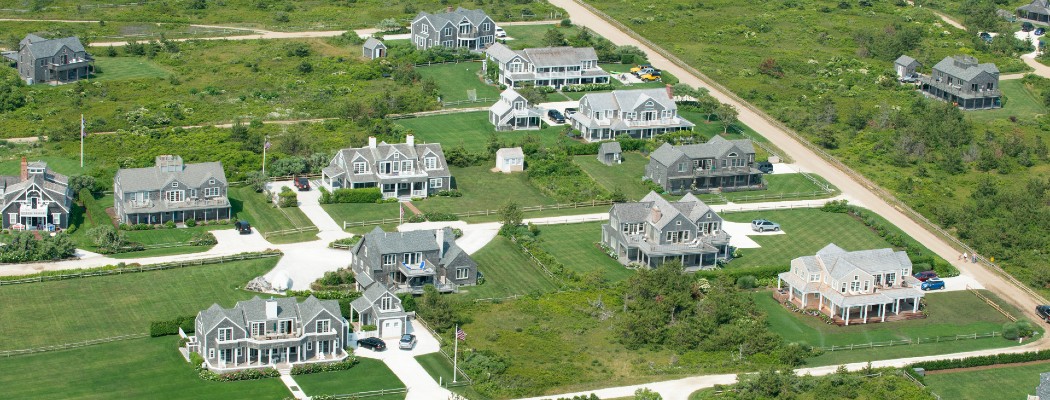Explaining the luxury real estate phenomenon.
By June of this year, Nantucket’s real estate market had already banked $880 million in sales and is now well on its way to matching—if not besting—last year’s record-breaking tally of $1.9 billion. As inventory has tightened, prices have soared. At press time, only four properties on the market were listed for under $1 million, and the median sale price had risen from $1.5 million in 2019 to $2.1 million this year. As dramatic as the market move might seem on Nantucket, other resort areas have experienced equal if not greater home value appreciation. From Aspen to the Hamptons, Jackson Hole to the other island across the way, home prices in luxury markets have exploded. The question is why would a pandemic, which would seemingly dampen economic activity in the United States, create such a contradictory impact on luxury housing?
Palm Beach epitomizes the explosion in prices in the luxury real estate market. According to Margit Brandt, a leading broker at Brown Harris Stevens Palm Beach, “The pace of the market has moved at its fastest rate in at least a decade. The number of sales has exploded 67 percent in the last year with the average price per single family home going from $8,785,000 in Q1 2020 to $12,857,000 in Q1 2021 on Palm Beach Island.” Brandt also indicated that the average price per square foot rose to the highest level ever recorded, with interior homes on Palm Beach Island fetching $2,000 to $3,000 per foot. Meanwhile, oceanfront residences are going for as high as $7,000 per foot.
To put it into perspective, Palm Beach—which has a population roughly a quarter of the size of Nantucket’s—saw a residential sale volume of $1.2 billion during the months of January, February, and March alone. Indeed, Palm Beach can make Nantucket’s market move almost look anemic. Few offerings demonstrate the hyperinflation of values in Palm Beach more strikingly than a property recently on the market by Gary Pohrer of Douglas Elliman for $2 million. What’s the catch? It was $2 million a year to rent. “Just when you think this market cannot go any higher,” Pohrer said, “we keep seeing evidence that it has not reached its peak.”
The paradox of high-end economic growth during COVID-19 is explained by Harvard economist and summer resident, Greg Mankiw. “The biggest impact on the wealthy has been the large reduction in interest rates engineered by the Federal Reserve,” Mankiw explained. “A fall in interest rates raises the value of long-lived assets, like stock and real estate. However, it also means a lower rate of return on wealth going forward. So the overall impact is not as big as it might first seem.”
As it relates to the luxury real estate boom, Mankiw again points to low interest rates as a major contributing factor, adding that “compared with the returns available on alternative investments like stocks and bonds, real estate looks attractive, which drives up prices.” If interest rates start to rise significantly over the next few years, Mankiw believes that the real estate market would soften. “That is very possible, especially if inflationary pressures prove persistent, though perhaps not the most likely outcome.”
Mankiw views the rise of the virtual workplace as a motivating factor for people buying vacation homes in places like Nantucket and turning them into full-time residences. “An interesting question is to what extent working from home will continue post-pandemic,” Mankiw said. “Some employers are encouraging workers to come back to the office. Others are deciding that working from home can be efficient and that it means they need less office space, reducing costs. At this point, it is an open question which of these two groups of employers will be dominant going forward.”
On a more granular level, few have a better read on the Nantucket real estate market than the local agents who have been riding this rocket ship for a year and a half. “It’s my belief that the initial driver of this demand was primarily emotional—buyers who were considering purchasing on the island sped up their timeline in 2020 as Nantucket was considered a bit of a safe haven from the pandemic,” explained Jen Shalley Allen, one of the principal brokers of Fisher Real Estate. “This year, the emotional component remains, but there has also been substantial wealth generation for many of the island’s visitors. Nantucket real estate typically tracks the stock market. Add to this the fact that buyers can access record-low mortgage rates and it’s truly a perfect storm for demand.”
Buyers are so hot for the Nantucket market that some are closing on homes without ever stepping inside. “Over the past year, I’ve seen my partner Chris Bloom represent a buyer who purchased an oceanfront listing sight unseen,” said Holly Finigan, an agent at Centre Street Realty. “We’ve accepted offers on two listings from clients who saw the property over FaceTime. What we’re seeing is that when buyers know what they want, they act fast to get what they want.”
This soaring demand, matched with dwindling supply, has resulted in dramatic acceleration of real estate prices. “In this market, people on the fence about selling decide to list their property at prices bordering on aspirational,” said Greg McKechnie, principal broker at Great Point Properties. “We recently listed a home that we had initially priced in April. In this market, we added an 11 percent premium on the April pricing. Within a week of listing, we received four offers, and the property is under agreement at 7 percent over asking.” While McKechnie said that there will inevitably be some “hiccup” to curtail this unprecedented rise of the market, he believes that while they might stall and have a slight pullback, prices will not return to their previous levels.

John Arena, a broker associate of William Raveis, indicated that the lack of inventory is even more extreme when looking at the plots of land available on the market. “From an average inventory of fifty to sixty parcels listed at any given time, we’re down to just under twenty,” he said. “And only one of those plots has been listed for under a million.” And that parcel, 6 Flint Road, is only for commercial use. According to Arena, the lack of inventory also extends to the rental market, which has seen a 20 percent decrease. Not surprisingly, the demand for rentals has skyrocketed by 40 percent.
The irony of the meteoric rise in luxury home prices is that it was a direct byproduct of government policy designed to help the lower end of the economic spectrum. In an effort to help those hit hardest by the pandemic, the federal government, during both the Trump and Biden administrations, has kept interest rates historically low while stimulating the economy at unprecedented levels. While stimulus checks and PPP loans have helped those in need, it has turbocharged many of the asset classes owned by America’s top 1 percent and has resulted in one of the most dramatic surges of value in housing prices in memory. For those who already own a home on Nantucket or other resort communities, these are the best of times. But for those trying to buy a home in Nantucket, that ship may have sailed.







